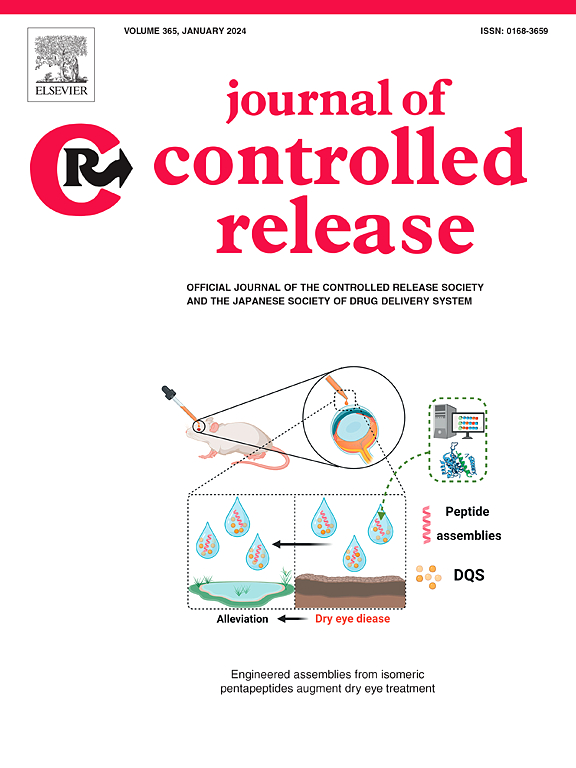Neutrophil membrane engineered human umbilical cord MSC-derived sEVs enhance anti-tumor efficacy for gastric cancer via delivering pentraxin 3
IF 10.5
1区 医学
Q1 CHEMISTRY, MULTIDISCIPLINARY
引用次数: 0
Abstract
Gastric cancer poses a significant global health challenge, promoting ongoing updates and exploration of treatment strategies. In this study, we proposed the naïve human umbilical cord mesenchymal stem cell derived small extracellular vesicles (hucMSC-sEVs) effectively inhibit gastric cancer proliferation and migration, presenting a promising bioactive agent for gastric cancer therapy. To address the issues of shortage in circulation time, limited targeting efficiency, suboptimal therapeutic outcomes associated with hucMSC-sEVs, we engineered a membrane fusion between hucMSC-sEVs with human neutrophil membrane, creating Neu/MSC-sEVs. This modification enhanced tumor cell targeting, reduced clearance by the mononuclear macrophage system, prolonged circulation time, and improved therapeutic efficacy. Furthermore, inhibiting the tumor suppressor protein pentraxin 3 (PTX3) in hucMSC-sEVs attenuated their anti-tumor effects, indicating that enrichment with PTX3 enhances the tumor-inhibiting potential of hucMSC-sEVs. Overall, our findings shed light on the mechanism by which hucMSC-sEVs exert their therapeutic effects on gastric cancer and underscore the importance of vesicle modification in enhancing targeting precision and therapeutic outcomes. These findings provide new insights for clinical application of modified vesicles in cancer treatment.

中性粒细胞膜工程人脐带间充质干细胞衍生的sev通过传递戊霉素3增强胃癌的抗肿瘤作用
胃癌对全球健康构成重大挑战,促进了治疗策略的不断更新和探索。在本研究中,我们提出naïve人脐带间充质干细胞衍生的细胞外小泡(hucMSC-sEVs)能有效抑制胃癌的增殖和迁移,为胃癌治疗提供了一种很有前景的生物活性药物。为了解决与humscs - sev相关的循环时间短、靶向效率有限、治疗效果不佳等问题,我们设计了humscs - sev与人中性粒细胞膜之间的膜融合,创造了new / msc - sev。这种修饰增强了肿瘤细胞的靶向性,减少了单核巨噬细胞系统的清除率,延长了循环时间,提高了治疗效果。此外,在hucmsc - sev中抑制肿瘤抑制蛋白戊素3 (PTX3)会减弱其抗肿瘤作用,表明富集PTX3增强了hucmsc - sev的肿瘤抑制潜力。总之,我们的发现揭示了humscs - sev在胃癌中发挥治疗作用的机制,并强调了囊泡修饰在提高靶向精度和治疗效果方面的重要性。这些发现为修饰囊泡在癌症治疗中的临床应用提供了新的见解。
本文章由计算机程序翻译,如有差异,请以英文原文为准。
求助全文
约1分钟内获得全文
求助全文
来源期刊

Journal of Controlled Release
医学-化学综合
CiteScore
18.50
自引率
5.60%
发文量
700
审稿时长
39 days
期刊介绍:
The Journal of Controlled Release (JCR) proudly serves as the Official Journal of the Controlled Release Society and the Japan Society of Drug Delivery System.
Dedicated to the broad field of delivery science and technology, JCR publishes high-quality research articles covering drug delivery systems and all facets of formulations. This includes the physicochemical and biological properties of drugs, design and characterization of dosage forms, release mechanisms, in vivo testing, and formulation research and development across pharmaceutical, diagnostic, agricultural, environmental, cosmetic, and food industries.
Priority is given to manuscripts that contribute to the fundamental understanding of principles or demonstrate the advantages of novel technologies in terms of safety and efficacy over current clinical standards. JCR strives to be a leading platform for advancements in delivery science and technology.
 求助内容:
求助内容: 应助结果提醒方式:
应助结果提醒方式:


